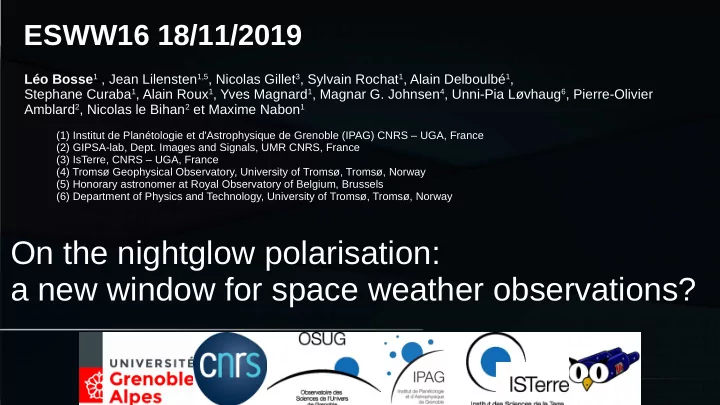

ESWW16 18/11/2019 Léo Bosse 1 , Jean Lilensten 1,5 , Nicolas Gillet 3 , Sylvain Rochat 1 , Alain Delboulbé 1 , Stephane Curaba 1 , Alain Roux 1 , Yves Magnard 1 , Magnar G. Johnsen 4 , Unni-Pia Løvhaug 6 , Pierre-Olivier Amblard 2 , Nicolas le Bihan 2 et Maxime Nabon 1 (1) Institut de Planétologie et d'Astrophysique de Grenoble (IPAG) CNRS – UGA, France (2) GIPSA-lab, Dept. Images and Signals, UMR CNRS, France (3) IsTerre, CNRS – UGA, France (4) Tromsø Geophysical Observatory, University of Tromsø, Tromsø, Norway (5) Honorary astronomer at Royal Observatory of Belgium, Brussels (6) Department of Physics and Technology, University of Tromsø, Tromsø, Norway On the nightglow polarisation: a new window for space weather observations?
Electrons entry in the upper atmosphere ● Electromagnetic fields guiding electrons ● Excitation of upper atmosphere ● Radiative desexcitation 18/11/2019 Leo.Bosse@univ-grenoble-alpes.fr 2
Transitions Atomic oxygen: ● Red (630 nm) ~200km ● Green (557.7 nm) ~110km Nitrogen N 2 + : ● Blue (427.8 nm) ~85km ● Purple (391.4 nm) ~85km Credits: NASA 18/11/2019 Leo.Bosse@univ-grenoble-alpes.fr 3
Polarization processes ● Aurora polarization (Bommier et al., 2011) parallel to electron’s incoming direction ( theoretically possible in the red, not in the green) ● Rayleigh scattering in lower atmosphere 18/11/2019 Leo.Bosse@univ-grenoble-alpes.fr 4
Interests and applications ● Discovery of auroral emissions polarization (Lilensten et al. 2008, 2013, 2015, 2016) ● Indirect and real-time monitoring of electromagnetic field in the transition region between internal and external magnetic field – Satellites too high – Balloons too low 18/11/2019 Leo.Bosse@univ-grenoble-alpes.fr 5
Instrument: Petit Cru Color filter Incoming light Photomultiplier Rotating polarizing filter Intensity time series 18/11/2019 Leo.Bosse@univ-grenoble-alpes.fr 6 Time
Q1: Where does it come from? 18/11/2019 Leo.Bosse@univ-grenoble-alpes.fr 7
Q2: How is the green line polarized? 18/11/2019 Leo.Bosse@univ-grenoble-alpes.fr 8
Conclusion ● The night sky is polarized ● 2 possible sources of polarization: – Upper atmosphere: Aurora / night-glow – Lower atmosphere: ● Rayleigh scattering : From aurora / city lights ● Aerosols ● New space weather proxy once disentangled ● Radiative transfer model and controlled environment to help us discriminate 18/11/2019 Leo.Bosse@univ-grenoble-alpes.fr 9
Q3: Can we model RS contribution? N E S O N 18/11/2019 Leo.Bosse@univ-grenoble-alpes.fr 10
Recommend
More recommend